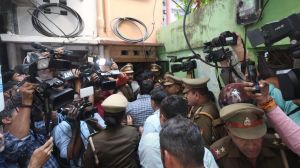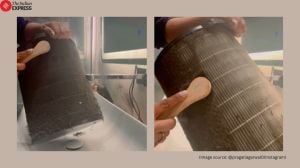Ahead of Holi, mosques covered with sheets on Ram Baraat, Laat Saaheb procession routes in UP
The mosques in Shahjahanpur and Bareilly have been covered as a precaution so that “no mischievous element does anything to disturb communal harmony” during Holi, the Bareilly SSP said.
 A mosque in Aligarh, Uttar Pradesh covered with black plastic sheets ahead of Holi celebrations.
A mosque in Aligarh, Uttar Pradesh covered with black plastic sheets ahead of Holi celebrations.All mosques on the Ram Baraat route in Bareilly and the Laat Saheb procession path in Shahjahanpur have been covered with tarpaulin and plastic sheets to prevent them from being smeared with Holi colours, which could affect communal harmony in the two Uttar Pradesh districts, authorities informed.
Senior Superintendent of Police (Bareilly) Ghule Sushil Chandrabhan led a police march along the proposed route of the Ram Baraat which will be taken out from Narsingh Temple on Sunday. The Brahmpuri Ramlila Committee has been organising the yatra over the years amid heavy police cover, and as a precaution all mosques on the route have been covered with tarpaulin.
“We held a meeting with clerics in the district on Friday and they have been told that the mosques will be properly covered so that no mischievous element does anything to disturb communal harmony. All clerics expressed satisfaction with our arrangements. A posse of police personnel will accompany the yatra which, after passing through many areas in the city, will return to the Narsingh Temple,” the SSP said.
Ahead of Holi, mosques covered with sheets on Ram Baraat, Laat Saaheb procession routes in UP
Read here: https://t.co/X1rdPMedwG pic.twitter.com/UBFxPmWOkl
In Shahjahanpur, a Laat Saheb ki Baraat is taken out on Holi from the Phoolmati Devi Temple. It features a unique tradition, reportedly prevalent since the 18th century, in which revellers hurl footwear at the procession featuring a buffalo cart and a hapless man. Earlier, the procession was called the Nawab Saab ki Baraat and the person sitting on the cart was depicted as a Nawab, but since Independence, it is known as Laat Saheb ki Baraat in which the person on the cart is portrayed as a Britisher.
Mosques located along the procession route remain covered with plastic sheets and the law and order machinery in Shahjahanpur is on high alert to avert any untoward incident.
“The baraat is a unique tradition here and I have been witnessing it since childhood. The person who sits in the buffalo cart is chosen nearly a month ahead and is housed at a secret location for the period, during which he is well-fed. People viewing the procession from their houses hurl footwear at him from their balcony. Once the baraat ends, the person is given new clothes and money by the organisers,” Gopal Sharma, a resident of Siddhivinayak Colony in Shahjahanpur, told The Indian Express over the phone.







